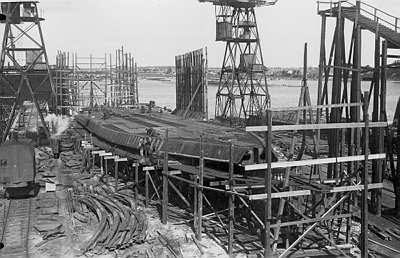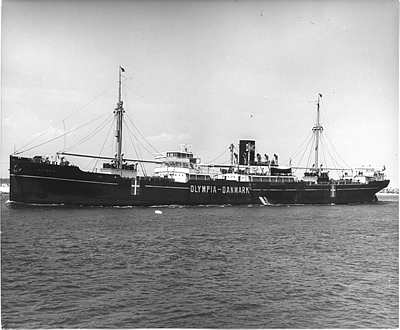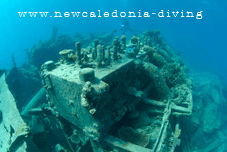The Mining of M.S. Snark

The 387-foot motor vessel Snark, formerly the Danish freighter M.S. Olympia, struck a mine and sank off New Caledonia in 1942. How it came to be towed by Worden in an abortive rescue attempt is a circuitous tale.
Olympia was launched in 1930, a twin screw diesel freighter built by Aktieselskabet Nakskov Skibsværft in southern Denmark. It was owned by Dampskibsselskabet Orient A/S (known as D/S Orient) and registered in Copenhagen. Designed for the Far East trade, Olympia had a modest beam of 54 feet and two engines with cylinders nearly 30 inches in diameter. In June 1931, it crossed the equator for the first time.
By the time World War II started in 1939, Olympia was a veteran freighter flying the neutral flag of Denmark. Its agents, the Danish-American firm Isbrandtsen-Moller Steamship Company (known as ISMOLCO), specialized in routes between New York and the Far East.
Suspecting that the Nazis would soon invade Denmark, the shipping entrepreneur Hans Isbrandtsen had moved many Danish ships out of Germany’s reach during early spring 1940. On 9 April 1940, Germany invaded and occupied Denmark. Whether by design or luck, just before the Nazi invasion Olympia was in Bombay, where it loaded about $1 million in gold from a nearly unguarded pier and then sailed.
On 17 April, Olympia (and the gold) arrived in Boston and sat for nearly a month, apparently while the fate of the cargo was decided. Meanwhile, the British announced that ships from Nazi-occupied territories were liable to seizure on the high seas.
Still in Boston on 14 May 1940, Olympia unloaded the Bombay gold and was then given a new paint job. Since the United States was still a neutral power, Olympia could legally leave for its next scheduled port-of-call, New York. However ISMOLCO claimed that British warships were waiting just offshore and would board Olympia as soon as it left U.S. territorial waters.
Accidental torpedoing by German U-boats probably posed a more immediate threat.


Shadowed by the U.S. Coast Guard and without any cargo, Olympia made the passage to New York via the Cape Cod Canal without incident (see photos, right) — but got no farther. It spent the next year tied to a New York Harbor pier while the owners and operators negotiated its release. On 31 March 1941, all Danish ships in U.S. ports were boarded by the United States Coast Guard for the announced reason of preventing sabotage; in reality, it was to discourage hasty departures and German legal maneuvers that might allow the ships to sail before they could be legally seized.
A week later, Congress passed a law allowing Danish ships to be taken over by the United States Government. The U.S. Maritime Commission ordered the Coast Guard to seize Olympia at its berth in Hoboken, New Jersey, on 12 July 1941. In August, the Maritime Commission issued an urgent appeal to the Danish sailors to remain at their posts, and offered lucrative wages and benefits to sweeten the deal.
Olympia eventually emerged from New York as the Panamanian-flagged motor vessel Snark of the United States Lines, at 4,488 registered tons under ownership of the U.S. Maritime Commission. The Panamanian flag allowed the United States — which was still neutral — to sail with war-related cargo into Allied ports where American-flagged vessels were barred by federal law.
The ship was rechristened after the famed thoroughbred race horse Snark — a name only coincidentally shared with Jack London’s famous turn-of-the-century cruising yacht. (In 1908, London had reluctantly sold his beloved Snark in Sydney, Australia, and it was eventually found abandoned in the New Hebrides.)
The 1940s Snark found its way to Australia and received orders to sail for New Caledonia. It departed Sydney on the night of 18 February 1942 with a cargo of baled wool.
Snark tried to cross the barrier reef near Nouméa on the morning of 24 February 1942; unable to raise the Nouméa pilot on the radio, an hour later the captain decided to return to the open sea and try later.
The captain, Olaf Pedersen, knew the area well but was unaware that just a few days earlier more than 2,000 mines had been planted because of fears that the Japanese might invade New Caledonia. Sailing without a harbor pilot, Snark struck an Australian mine while outbound in Boulari Passage, a critical gap in the New Caledonia Barrier Reef directly opposite Nouméa.
The explosion, just below the bridge, injured the first and third officers and caused the crew to abandon ship. The ship heavily listed to port and started sinking by the bow.
Meanwhile, on 21 February Worden had reached Nouméa from Pearl Harbor, having escorted the seaplane tender Curtiss and the fleet oiler Platte. It fell upon Worden and several smaller support vessels to keep Boulari Passage open.
Snark was about 40 feet (12 meters) longer than Worden and of course laden by cargo and flooding. The goal was to keep the channel open, and a few of Snark’s crew reboarded the stricken ship to assist in beaching it.
Complications immediately arose when Snark’s small crew prematurely raised anchor before Worden’s heavy tow line could be brought aboard. A lighter rope, known as a messenger line, bore the full mass of the sinking ship.
Taking Snark in tow despite the miscue, Worden headed northwest past Amédée Lighthouse but only got about 1,500 yards. The light messenger line snapped in heavy winds and the 12-year-old freighter twisted and then ran hard aground, foundering on a sandbar adjacent to a reef. Worden’s skipper, Commander William G. Pogue, decided that further efforts would be both dangerous and futile, and ordered that the salvage be abandoned. Worden’s medical department tended to six injured men and then returned Snark’s entire 35-man crew to port; the French captain of the port declared the ship to be beyond repair.
However, Worden accomplished its primary mission: The vital channel was kept clear.
Today, the distinctively pointed bow, the enormous diesel engines and a propeller are the only identifiable remains of Snark. Its wreckage is a favorite of scuba divers, and it lies in about 30 feet of water on L’Epave du Snark — Snark Reef.

Sources:
New Caledonia Diving
American Merchant Marine at War
The New York Times
“American Viking: The Saga of Hans Isbrandtsen and his Shipping Empire” by James Dugan; Harper & Row, 1963.
“A Historical Dictionary of the U.S. Merchant Marine and Shipping Industry” by By Rene De La Pedraja; Greenwood Publishing Group, 1994.
“With Constant Care — A.P. Møller: Shipowner 1876-1965” by Ove Hornby; Schultz Förlag, 1988.
PortCities Southampton Plimsoll Ship Data project
Danish Maritime Museum